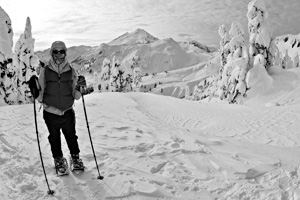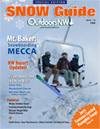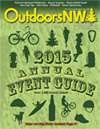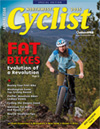Editor’s Note: Getting avy savvy with a backcountry dummy

By Diane Rudholm
Photo at right: Author bundled up for beacon practice at Artist Point, elevation 5,200 feet. Photo by Elaina Jorgensen
The sun was sinking into the valley when my two friends and I pulled up to the Mt. Baker Lodge, 55 miles east of Bellingham, Wash., for the final fieldtrip of our AIARE Level I avalanche course.
We’d been blasting the heater to stay warm on the car ride up but were still decked out in down jackets and Gortex. Only after we added another layer of clothes and tightened our snowshoes and gaiters did we make the multiple trips up a steep snowbank to store our gear inside.
A cold front brought us subfreezing temperatures that night, bursting a bathroom pipe right before the 50 or so guests prepared for sleep. The mishap added an extra element of nervousness and excitement to a weekend that already provided both.
In the morning, we got ourselves fed and out the door right away. It wasn’t long before I had to trade out my gloves for a second dry pair, and I was relieved to find that plenty of people seemed to have extra hand and feet warmers and were willing to share.
“Would you ski that line?” Our group leader gestured toward Mt. Herman. A few fearless skiers were bombing down the mountainside with snow sloughing away from the earth behind them.
“Nope,” I said. “Not a chance.”
“And, why not?”
“Wind loading,” a classmate said. “Look up there. All it would take is for someone to get a little too close to that cornice and the guys below would be swept away or buried.”
After getting a firsthand look at the kinds of dangerous terrain we had been discussing in class, everything started to look like a deathtrap. Maybe I didn’t need to ski in the backcountry. Maybe I’d take up macramé.
Practice dummies
We practiced using beacons to find a Styrofoam dummy buried a few inches beneath the snow. Everyone’s beacon was different. They transmitted signals in different patterns at different distances and led everyone in arcs or circles. It is vital to practice using avalanche gear in a safe spot well before you find yourself having to figure out those differences in an emergency.
Our group split up and took turns burying the dummy, hiding our tracks and watching the poor thing meet its demise again and again. One person would follow their beacon’s signal to get as close as they could to the burial site. Another person would slide their probe into the snow in a spiral pattern until they made solid contact with the foam victim. Then the rest of the group would dig as quickly as their arms would let them, hopefully saving the day.
I was one of the first people to practice with the probe. I thrust my probe deep into the snow a few times before hitting an ice crust. My probe was stuck. As it turned out I had actually stabbed the dummy clean through. That couldn’t happen to a real person, right? I looked at my dummy-stabbing probe with dismay.
That could’ve been my eyeball, I thought. Macramé was looking more and more appealing by the minute.
Accessing levels of risk
Tired and hungry and a little grim, our group continued up to Artist Point for more beacon practice and a change of view. We kept at it until complaints of aching toes and fingers began to seep into conversation.
A few photographers in the group were reluctant to leave our perch despite chattering teeth, but after some coaxing and promise of hot coffee, the group agreed to head down to the lodge to review what we’d learned.
On the way, we saw a man on a fat-tire unicycle spill down a slope over and over again, laughing to his friends who obviously wanted to try their luck, too. Down a little farther, there were skiers and boarders hucking a too-tall cliff with unrestrained bliss.
I would never do that, I thought. But, I also would have been disappointed to have not watched their fun or to have missed Mt. Baker’s glowing silhouette if I would have stayed home making macramé owls.
We all have ideas of what level of risk is acceptable in a given situation. Mine is different than the skiers spraying powder behind them on Mt. Herman or gliding toward cliff drop-offs at top speeds. But, I’d rather go out and enjoy backcountry touring safely with a well-devised plan than to not go out at all.
Diane Rudholm is the managing editor and social media coordinator of OutdoorsNW. Her avalanche training was made possible by a Yuki Award from the Monika Johnson Avalanche Education Scholarship and the Everett Mountaineers. Send comments here or @OutdoorsNWmag
NW Avalanche Resources
AIARE Courses: www.aiare.info/course_list.php
Northwest Avalanche Center (NWAC): www.nwac.us
Tree Well Info: www.deepsnowsafety.org
Yuki Award: www.turns-all-year.com/yukiaward.html
If you like this post, you might also enjoy:
Editor's Notes Features Home Recent Articles Snowsports The OutdoorsNW Blog



